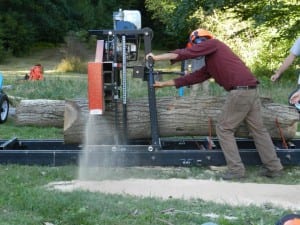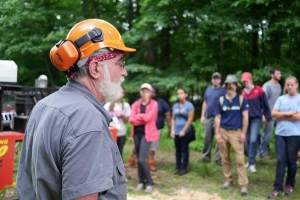-Article by Tom Worthley, Extension Forestry-

During a conversation in 2010 between myself and a teacher from the industrial arts department at Haddam-Killingworth High School, the suggestion was made that the School District could continually grow, harvest and process a portion of the annual lumber needs for the shop class from part of of 150 wooded acres owned by the district in Higganum. This could be accomplished under a sustainable forest management plan properly incorporating a forest products objective. The idea took hold and with the encouragement of the Regional School District 17 Superintendent’s office, Board of Education and the cooperation of a committee of teachers.
UConn Extension staff members and students on a service-learning project (supported by the USDA Forest Service and the Natural Resources Conservation Service) inventoried and developed a Forest Stewardship Plan for the property. Educational, forest improvement, recreational, habitat and wood products goals were addressed in the plan. In addition to an educational trail and some habitat enhancements, a recommendation in the plan for one area was to conduct a low thinning for stand improvement, which, when implemented, produced some cordwood and small sawlogs. Value-added operations conducted on-site, such as splitting and stacking the cordwood and milling the logs into lumber with a portable band-saw mill turned the thinned material into usable products that were used to benefit the school. The project illustrated one way local woodlands can be managed for multiple benefits and sustainability including forest products for local use. Demonstrating how this can be accomplished by means of small-scale, low impact harvesting combined with value-add local processing and manufacture, a material connection between the average citizen and the forest resource might be re-established, thus elevating local appreciation for local forestlands. The site remains available for educational purposes.

About a year and a half ago I was contacted by the Southington Open Space Committee for advice, typical with towns, “Now that we have conserved this land what should we be doing with it?” I met with them and listened to their ideas and, of course, suggested a management plan would be in order and that there were several options available to them for developing a plan.
One of the options suggested, if they were willing to be patient, was to involve some student and volunteer effort and work with us. My request was that I would want to extract as much educational value from the process as possible. As it happened I had a recently graduated Coverts Cooperator in town willing to volunteer some time and there were three NRE students seeking undergraduate field internship academic credit, so the planets were somewhat aligned.
We put the students to work conducting assessments and field inventory and suggesting some management recommendations that could be incorporated into the plan. Ultimately a draft was sent to the committee for review, with three main recommendations for the forest vegetation, these being to address the problem of invasive species, to salvage trees that were damaged in the 2011 storms and to conduct a thinning or other forest improvement treatment to address a declining ash component and perhaps not lose the value of that resource.
As luck would have it we also discovered emerald ash borer at this location during the summer, so the question of what to do with the ash became somewhat more urgent. One of the committee members had heard about the RSD-17 project and was interested in providing lumber to their high-school tech arts program. They asked whether some harvested ash might be utilized in this way.
Furthering the goal of raising awareness for locally grown forest products I suggested that we could initiate a thinning at one spot as an on-site demonstration of what trees should be removed and what trees kept and that anything large enough could be milled on-site and the lumber sent for use at the school. I would just need permission to (gasp!) cut a few trees down. Ultimately this endeavor became a workshop for town and school staff focused on small-scale harvesting techniques, chainsaw safety and portable sawmilling. We made nice ash boards out of poor-looking logs that the school technical arts faculty were quite delighted to have. On the day of the workshop we were also visited by one class of high school students and a couple reporters, resulting in a nice Channel 3 news report.
We scheduled and conducted another field walk and demonstration for the public, a few weeks later for which we had about 40 attendees. The Hartford Courant wrote an article about this demonstration.

In the meantime, with the local harvesting and utilization taking place (even such small quantities) for the right reasons and under a sustainable plan, CT-DEEP Forestry staff thought it might be a good opportunity to highlight the “Connecticut Grown” program and give some recognition to the community. Application materials were provided to the Open Space Commission and CT-DEEP Program Leader Doug Emmerthal shepherded the application through the process. Southington’s Crescent Lake thus became the first town forest enjoying “CT-Grown” status.
At this point it has been suggested that the town establish a relationship with a private consulting forester to carry through with plan implementation. They are seeking proposals now. Hopefully some local entrepreneur might also see an opportunity with the town with local wood products.
To sum up: A request for advice could have simply been directed to the list of private consulting foresters at the beginning. Instead we invested several days of Extension faculty time, some NRE student time and NRE vehicle and equipment use.
Resulting educational outcomes have included:
- Field Internship credit hours for three NRE students;
- an informed and educated 12-member Southington Open Space Commission;
- one Coverts Cooperator outreach project involving an evening presentation and a volunteer recruitment effort at the community level for training and action to control invasive species;
- workshop attended by 10 town and school staff on chain saw safety and operation and small-scale wood products harvest and processing;
- one field trip by a class from Southington High School;
- 10 members of the public attended an evening presentation about the management plan contents;
- 40 members of the public attended a field walk and demonstration at the site;
- between 300 and 400 board feet of ash lumber (1×6 and 1×8 boards) delivered to Southington High School to be used in technical arts education;
- several newspaper articles and one television news report;
- first CT-Grown recognition for a town-owned forest.
Appropriate credit must also be acknowledged, as several members of CT DEEP staff were very helpful and the enthusiasm and energy of several members of the Southington Open Space Commission have been key to this success.
I am presently in discussion with members of the technical arts programs at two additional school districts to find out whether similar programs can be replicated in their communities.